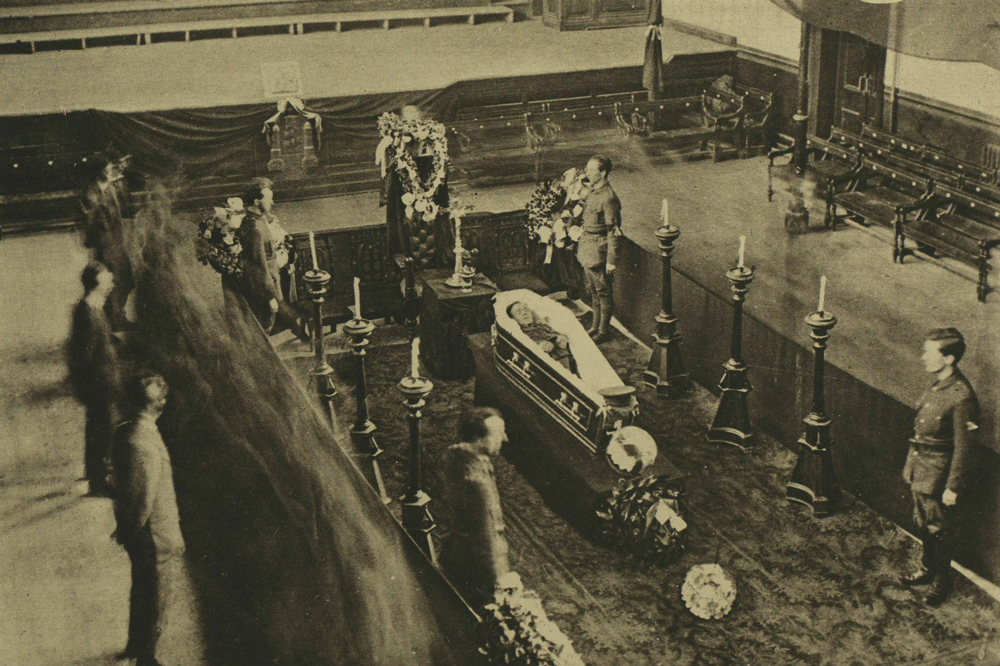Murdered Lord Mayor laid to rest in Cork
Cork, 24 March 1920 - The remains of Alderman Tomás Mac Curtain were laid to rest in St Finbarr’s Cemetery in Cork on 22 March.
The republican Lord Mayor was killed on 20 March when armed men entered his home in the Blackpool area of the city and shot him at close range.
His funeral was observed as a civic holiday in Cork and the cortège that followed his coffin was the largest in living memory in the city, with all classes and creeds represented. Black flags and flags bearing the republican colours were hung from City Hall and from businesses and private houses.
Alderman Mac Curtain’s remains rested overnight in the Roman Catholic Cathedral where a Requiem Mass was held in his honour at 11am, celebrated by Dr Daniel Cohalan, the Bishop of Cork.
The procession from the cathedral to the graveyard left at 12.30pm and was headed by approximately 200 priests led by Dr Cohalan. It comprised almost 20,000 people and took 90 minutes to pass any particular point.
Representatives of public bodies, corporations, and various shades of nationalist opinion, including those from the old Irish Parliamentary Party tradition were in attendance. There were also senior figures from the Church of Ireland, the Presbyterian, Methodist and Jewish faiths in attendance.
-Funeral-of-the-Lord-Mayor-of-Cork-FJ2.jpg)
Left: Some of the mourners at the funeral, including Arthur Griffith and JJ O'Kelly. Right: Irish Volunteers carrying wreaths in the funeral procession. (Image: Freeman's Journal, 23 March 1920)
There was a strong turnout from the Volunteers, one estimate putting their number at 8,000, many of whom wore uniforms. Many pipers’ bands were also present and wearing their traditional costumes. Also represented were Cumann na mBan, the transport union, the Catholic Young Men’s Society and other groupings.
The procession passed the entrance to Cork Jail where Volunteers were positioned to ensure that large crowds would not obstruct the view of political prisoners from their cell windows which overlooked the roadway.
The Volunteers also policed the entrance to the graveyard, where access was restricted principally for immediate relatives and friends, among them Margaret Pearse, Áine Ceannt and Tomasina McGarry.
At the graveside, Terence McSwiney delivered the eulogy. He told mourners that while the work being done by the late Lord Mayor had been interrupted, it would continue all the same. Men would be found to take Tomás Mac Curtain’s place and no matter how many were stopped in a similar way, there were others who would come forward and take the lead. After the eulogy, a party of Volunteers fired a volley over the grave.
The Lord Mayor is survived by his wife and five children.

The procession passing along Camden Quay to St Finbar's Cemetery. (Image: Illustrated London News, 3 April 1920)
Inquest
The inquest into the death of the Cork Lord Mayor has already
heard startling suggestions that implicate the police in his
murder.
Among other revelations, the counsel for the family of the deceased noted that the raiders – who numbered 20 men in all, six of whom entered the house – wore civilian overcoats and caps, but carried rifles with straps such as those served out to the police and that men fitting their description were shortly after seen entering the King Street Police Barracks, which is situated only 40 yards from the Lord Mayor’s house.
Mac Curtain’s home has been raided over 20 times in four years by the police and it was clear that the raiders knew the layout when they entered. A policeman’s button was also discovered immediately outside the house.
The inquest is expected to continue for a number of days.
[Editor's note: This is an article from Century Ireland, a fortnightly online newspaper, written from the perspective of a journalist 100 years ago, based on news reports of the time.]





















